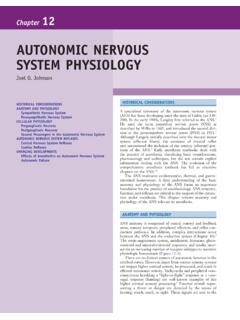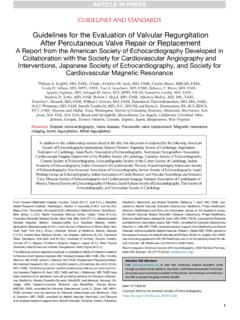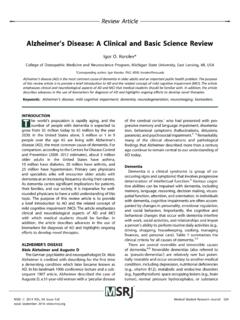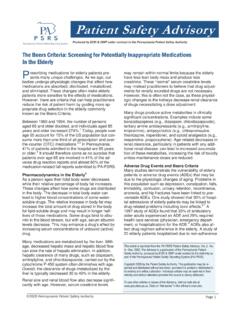Transcription of BIS monitoring: From the OR to the ICU
1 bis monitoring : from the or to the ICUFind out how bispectral index monitoring can give you an objectivemeasure of your patient's level of Ellie Z. Franges, RN, APRN,BC, CNRN, MSNC aring for critically ill patients in the ICU can presentmultiple challenges. Because of the physiologic dynamicsof critical illness, predicting the patient's need for anal-gesia and sedation is difficult. Until recently, the onlyphysiologic measures we had to ensure appropriatemedication use were indirectly tied to patient method often resulted in oversedation for patients,increasing ICU stays, and overall index (BIS) monitoring , an objective mea-sure of the patient's response to sedation, has been usedin anesthesia for over a decade.
2 This technology is find-ing its way into the ICU to provide a means of assessingthe adequacy of sedation and preventing oversedation ofcritically ill addition, because the BIS monitor reflects elec-troencephalographic data, it adds to the objective infor-mation regarding brain is also used to monitor sedation in patients withneurologic disorders, and clinical trials use BIS monitor-ing to improve sedation protocols in endoscopy and in-terventional BIS revealsBIS monitoring measures cerebral electrical activity de-rived from an electroencephalogram (EEC). The BIS de-vice reads the electrical activity from a sensor placed onthe patient's forehead and converts several parametersinto a single numeric value that correlates to sedationlevel.
3 The digital BIS value ranges from 0 (isoelectricEEC) to 100 (fully conscious).1 The bis monitoring system consists of a sensor and adisplay monitor. The sensor is an electrode strip. Threeof the electrodes, when properly placed, pick up EEC ac-tivity. A fourth electrode is used to measure artifact andelectromyographic (EMG) resistance, which sends sig-nals that contaminate EEC readings. The sensor is con-nected to the monitor that displays a single-channel EECtracing and the BIS monitor also provides information that can con-firm the reliability of the data. A high signal quality in-dex (SQI) indicates a reliable BIS value. The suppressionratio (SR), noted as a numeric value, indicates the per-centage of isoelectric The suppression ratio valuesare inverse to the BIS values.
4 A tracing without any iso-Spring 2009 Critical Care Insiderelectric periods would have an SR of 0, whereas a fullyisoelectric tracing would have an SR of The valueof the EMG indicator, which reflects muscle stimulation,will rise with any occurrence that increases muscle toneor movement. As the EMG value rises, the BIS value be-comes less how-toBeginners to bis monitoring can use the following the sensor: You can place the electrode stripon either side of the patient's forehead. First, gentlyclean and dry the patient's forehead to remove oils. Thesensor strip, which doesn't require any additional skinpreparation, has three circles to ensure placement torecord EEC activity.
5 Circle one is centered 2 inchesabove the nose. Circle four is placed above the eyebrowin a parallel fashion. Circle three is centered on the tem-ple between the corner of the eye and the hairline. (Cir-cle two doesn't have a specific placement.)Once the strip is placed, secure it by pressing aroundthe edges of each circle, then press and hold each circlefor at least 5 seconds to secure contact to the : Use the interface cable to connect thesensor to the monitor. The BIS monitor will display theraw EEC tracing, and within several minutes the BIS nu-meric value will stabilize. Check the SQI for reliability ofsignal. Document the baseline value; use the BIS value totitrate sedative medication.
6 (See BIS sedation scale.)Care and troubleshootingThe BIS monitor requires little in the way of trou-bleshooting. The sensor should be changed every 24hours. The monitor will alert you when the 24-hourperiod is the SQI decreases, check that the sensor is still ingood contact with the patient's forehead. Remember, ifthe EMG activity increases, the accuracy of your BISvalue decreases. Because EMG resistance reflects muscleactivity, search for and treat the cause of the EMG activ-ity. If it's pain, your interventions will include adminis-tering analgesics. If it's seizure, administer the patient needs to be immobile for medical treat-ment (such as an imaging study)
7 , you may need to ob-tain an order to add muscle relaxants or paralytics to thepatient's in actionLet's look at some scenarios in which BIS monitoringcan be Jiminez, 44, arrives at the ED after the sud-BIS sedation scaleBispectral index values for monitoring the sedationlevel in critically ill StateAnxiolysisModerate sedationDeep sedationBIS100 patient awake, responds to normal voice9080 patient responsive to loud commands or tactilestimuli7060 patient unresponsive to verbal stimuli5040 hypnotic state3020100 flat-line electroencephalogramSource: Aspect Medical Systems, onset of what she describes as the worst headacheof her life.
8 She had no focal neurologic deficits. Mildnuchal rigidity and headache were present on admis-sion. A computed tomography (CT) scan of the headdemonstrated a subarachnoid hemorrhage suspiciousfor a middle cerebral artery aneurysm. A CT angiogramconfirmed the presence of a left middle cerebral arteryaneurysm. Ms. Jiminez was taken to the OR for clipobliteration of the aneurysm. She was given propofolfor sedation because of its short half-life; a neurologicexam can be performed quickly after the infusion remained intubated and sedated postoperatively,and the BIS monitor provided objective informationabout her level of sedation. A postoperative CT scancompleted the morning after surgery showed no new he-morrhage, good clip position, and no indication of cere-bral edema.
9 During the morning exam, with thepropofol infusion off for 20 minutes, Ms. Jiminez wassleepy and commands with both upper extremities;however, her response was quicker on the left side thanthe on the second postoperative day, her BIS val-ues were trending lower than the desired range. The CTscan was repeated and showed no change from her im-Critical Care InsiderSpring 2009mediate postoperative scan. She had a transcranialDoppler study, which demonstrated high velocitiessuggestive of vasospasm. At the same time, propofolwas titrated down with no change in BIS values. Afterthe transcranial Doppler sonography, she was takenimmediately to the interventional radiology suite for acerebral arteriogram, which confirmed the was treated with intra-arterial papaverine.
10 After 20minutes, a repeat arteriogram demonstrated no furthervasospasm, so she was maintained on triple-H therapy(hypertension, hypervolemia, and hemodilution, de-signed to increase cerebral perfusion and reduce therisk of vasospasm). Her BIS values at this time were 40to hours after the intra-arterial papaverinewas administered and while Ms. Jiminez was still ontriple-H therapy, her BIS values dropped again. A CTscan of the head showed no change, but her intracranialpressure (ICP) values were trending upward from 15 to18 mm Hg and transcranial Doppler values showed in-creased velocities. Triple-H therapy was this period, she remained sleepy with someweakness of her right arm and would follow commandsonly intermittently.







